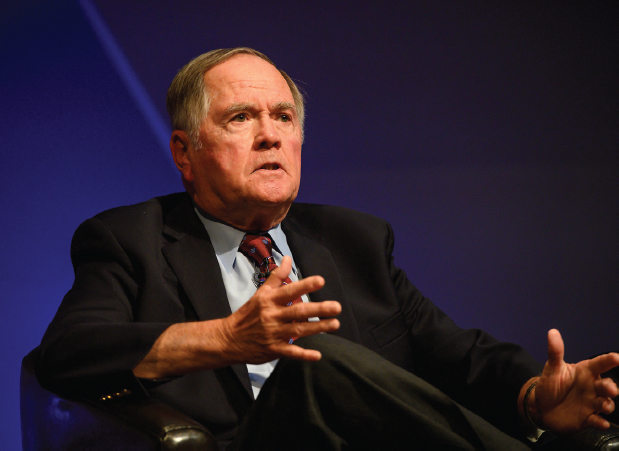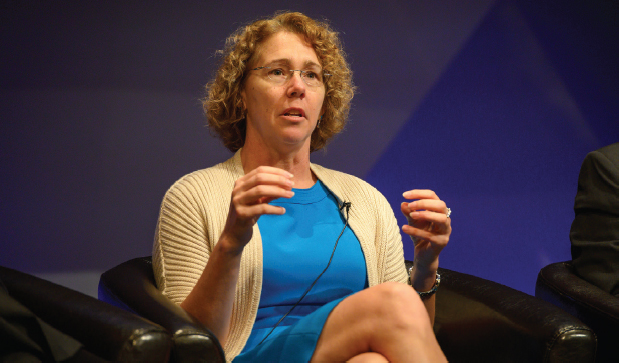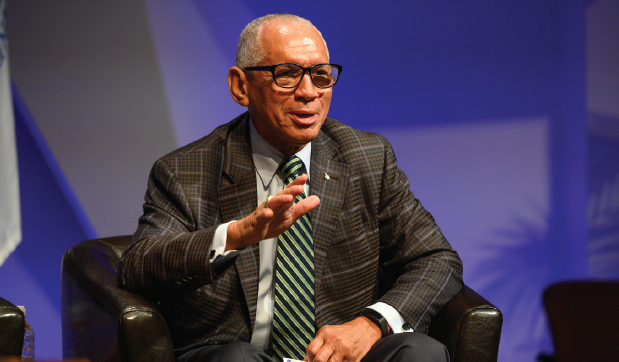2
The Space Shuttle and the
International Space Station
Robert Crippen joined NASA right after the Apollo 11 landing. He had been working on a classified Department of Defense program called the Manned Orbiting Laboratory, which was designed to take high-resolution photographs of the Soviet Union. When that program was cancelled, seven of the crew members were transferred to the NASA astronaut office. “We didn’t do any training, didn’t go through a selection process with NASA. We just walked in the door and they put us to work,” Crippen recalled.

FROM SKYLAB TO THE SPACE SHUTTLE
Crippen’s first assignment was to oversee the crew interfaces of Skylab, an orbiting space station that hosted US astronauts from May 1973 to February 1974. He was also a member of the support crew for the 1975 Apollo-Soyuz mission, and he and Stafford were among the first Americans to visit Star City and its Yuri Gagarin Cosmonaut Training Center in the Soviet Union. “I had the pleasure of tucking Tom and the rest of his crew into the command module for their launch on Apollo-Soyuz, so we go back a long ways.”
Crippen then worked on the development of the Space Shuttle, which first flew into space in 1981. Many people think of the job of being an astronaut as mostly training, he said, but most of his career with NASA involved engineering work. “I would imagine the current astronaut office is doing the same thing with the vehicles that are being developed today by Lockheed, Boeing, and SpaceX.”
John Young, the most experienced astronaut at the time, selected Crippen to be his crewmate for the first Space Shuttle flight. “It was great training with John and flying that mission,” said Crippen, “certainly one of the highlights of my life.” He went on to command three other flights in 1983 and 1984, much of which involved engineering work to “make sure the Space Shuttle would do what we had designed it to do.”
“Looking back, I am very proud of the Space Shuttle program,” Crippen recalled. “Yes, we had two terrible accidents. I lost some very close friends. But when you look at the sum of the 30 years that it was flying,…it will be a long time before we see a vehicle that is anywhere near as capable as that.” He reported that the Space Shuttle performed several missions for the Department of Defense that contributed significantly to winning the Cold War. It flew payloads like the Hubble Space Telescope and other space observatories that have revolutionized knowledge of the universe. It made possible the building of the International Space Station, “an engineering marvel that is still up there today doing its job.”
The termination of the shuttle program in 2011 was a great disappointment, primarily because the United States did not have another way of putting its crews in space and would have to depend on Russia for transport to and from the International Space Station,
Crippen observed. But he assured the audience that “the Starliner and the Dragon capsules are going to correct that problem very soon.”
EXPERIENTIAL KNOWLEDGE
Sandra Magnus was selected to the NASA astronaut corps in 1996 and flew on four shuttle missions, including the final shuttle flight in 2011. In November 2008 she traveled to the International Space Station (ISS), where she spent four and a half months as flight engineering and science officer. “When you are up there and you are experiencing it, it changes your perspective.”
“There is a big difference…between intellectual knowledge and experiential knowledge,” said Magnus, “between book learning and going into a lab and actually touching something. That is when you really understand things.”
She explained, for example, that astronauts who fly on the ISS adapt to weightlessness at a completely different level than do astronauts who are in space for just a few days. When a crew came to pick her up, she was surprised to see how awkward and unsure of their motions they were as they moved through the spacecraft. In contrast, she was able to bounce from object to object in the station as if she had been born there. “That’s when I realized I had adapted to a whole new level.”
One of her most remarkable experiences was coming back to Earth. As she reentered Earth’s atmosphere and slowed down, she experienced

gravity for the first time as an external force. Scientists and engineers understand gravity intellectually, she said; they can describe and quantify it. “But that is not the same thing as understanding it instinctively and internally” after becoming accustomed to its absence. “It makes you look at the world in a whole different way.”
She adapted to other things as well. “I took it for granted, looking out the window, that there was an Earth floating by below me, and the beauty of it, and how amazing that was.”
These kinds of experiences are why humans should go into space, she said. “It shifts our view of the world. We start thinking about questions that we should be asking but that we don’t think of because we take for granted the environment that we are already living in. It opens up our minds to new ways of looking at the universe.” And as people with different skills and perspectives go into space, they will ask new questions and arrive at new answers. “We are going to learn more from the questions that we learn to ask than from the answers we are getting.”
THE POWER OF DIVERSITY
Charles Bolden, who also flew four shuttle missions and was NASA administrator from 2009 to 2017, expanded on the theme of new perspectives and diversity. A legacy of the Space Shuttle, he said, was its introduction of inclusion to NASA. It enabled “people to fly who could not fly before.”

Women astronauts were one part of that expansion. NASA is now “using the other 51 percent of society that we didn’t use before,” Bolden said. “We have women heavily involved in everything that we’re doing, [including] leadership roles at the very top…. That’s something we didn’t have in the days of Apollo or the early days of the shuttle.”
Magnus is one of the women who benefited from this broadening. She said that she first dreamed of being an astronaut when she was in middle school. “I had no idea how I was going to do it. I had no idea if it was even possible.” Then, in 1978, when she was entering high school, she saw an article on the front page of her small-town newspaper headlined, “Women Accepted into the NASA Astronaut Corps.” “I started crying,” she said. “At that moment, I realized that the dream that I had was possible. There was a path. There were people like me I could identify with doing the thing that I had always dreamed of doing.”
Everyone can be a role model for some constituency, she said, whether that group is defined by gender, race, community, or age. The members of the NAE, she said, are particularly well suited to excite people about science and technology and to encourage more people to enter engineering. “Do not underestimate the power of role models.”
International collaboration brings another measure of diversity, Bolden noted. About 20 nations collaborate to make life possible on the International Space Station, reflecting the view from the station’s windows. From space, “there are no borders and boundaries,” he said. “You can’t tell where one group of people lives and another group of people lives.”
Attitudes were not always so open. When Bolden was asked in the early 1990s if he would fly a shuttle mission that included the first Russian cosmonaut, he was hesitant. But he had dinner with two cosmonauts, Sergei Krikalev and Vladimir Titov, “who are my dear friends to this day.” They talked not about technology but about their children. “We talked about what we wanted to do for the future. We became mission focused on figuring out how we could get our two teams together and successfully work on that mission. It became Shuttle-Mir, and now the International Space Station.” Stafford added that he had a similar experience with cosmonaut Alexei Leonov, who “is just like a brother to me. In fact, his granddaughter is named after my daughter, [and my] grandson was named after Alexei.”
RENEWED APPRECIATION FOR PLANET EARTH
One thing that made an indelible impression on Bolden from space was the thinness of the atmosphere surrounding the planet. “We need to take care of that” atmosphere, he said. “There is no planet B…. We need to learn how to take care of this one so we don’t need to be dreaming of other places where we can go live.”
Many more people will soon be able to go into space, even if just for 20 minutes or so, Bolden said. “That will change your perspective on this planet. If you get an opportunity, find a rich friend, get him to foot the bill for you,… You need to [go into space].”






